Dear Friends and neighbors,
The 2021 legislative session began in early January and we’re now barely three weeks out from the April 25 adjournment. For many reasons, this has been a session like none before in Washington’s nearly 150-year history.
Going into session, we feared that the massive changes required by the global COVID-19 pandemic would make citizen participation difficult; in fact, technology led to an opposite result, with greater opportunities for people in every corner of the state to interact directly with their government.
And when we opened the session in January, the Washington economy was reeling. Today, thanks to Washington’s strong business climate, the resiliency of its people, and an infusion of funding from the new federal administration, the outlook is far brighter than any of us could have predicted just a few months ago.
We’re not out of the woods yet, of course. We’ve lost thousands of our fellow Washingtonians to COVID-19. Though the economy is bouncing back, countless small businesses so vital to that economy have suffered or closed their doors forever, and countless Washington workers have borne the brunt of this slowdown. We’ve all grown more aware of fresh racial wounds and longstanding systemic inequities that tear at the fabric of our society. And climate change persists as the greatest existential threat that we have ever faced.
This year, your Legislature has addressed all of these issues and more, and we’ll continue to report on them in future updates. Today, in this special joint message, we want to focus on the three state budgets that are currently being negotiated in virtual Olympia, the spending blueprints that will shape our state over the next several years.
Our Washington Recovery Budget
Our “Washington Recovery Budget” is the third step in our Community and Economic Recovery Plan, using state and federal funds from the American Rescue Plan to support people hit hardest during the pandemic, prioritizing the needs of Black, Brown, and Indigenous communities that have suffered the most and face the most barriers to recovery.
Watch this short video on why we need this budget now:
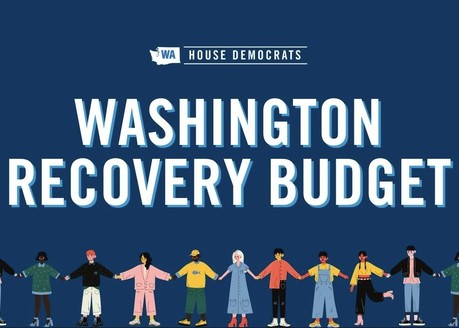 |
This comprehensive plan will get us on the path to recovery by:
- Paying the back due rent and offer utility assistance to struggling families,
- Providing small business grants and unemployment insurance tax relief to help keep doors open,
- Expanding food assistance programs so children don’t go hungry,
- Investing in our early learning and childcare system so that families can go back to work when it is safe, knowing their children are safe too,
- Getting cash in hands to people with immediate need who have historically had barriers and limitations that stopped them from getting help, and,
- Boosting public health so that vaccines are available to everyone in our state as quickly and equitably as possible.
Washington communities are hurting. Renters have an unprecedented $1 billion in back rent, 30 percent of residents do not have reliable access to food, and families are worried about how they’ll stay afloat. We recognize folks’ needs in so many communities: a roof over their heads, money to keep their small businesses open while ensuring their customers and staff are safe, vaccines in every community and health care infrastructure to support them, and relief for Indigenous, Black and Brown communities, as well as communities of color who have suffered the most from COVID-19, physically and financially.
Instead of coming back for a Special Session over the summer and making unnecessary and harmful cuts, we spent the last few months listening to constituents like you, and to our trusted messengers and community partners serving the community. We also heard from community-based organizations, our local elected leaders, and neighbors in our district most impacted by the programs the state provides.
The people of Washington have done their part, made great sacrifices, and stepped up to protect lives. Now it is time for the Legislature to do its part and pass a budget that not only tackles the challenges of today, but those of the future.
Click here or on the image below for a video on some of the key investments included in our budget.
 |
In 2009, when the Great Recession hit, Washington scaled back. Did less. Helped fewer people. That led to long waiting lists, barriers that left out people who needed help, a criminalization of poverty that hurt far too many, usually Indigenous, Black, and Brown families, and shamed people from seeking help.
We cannot do that again. We must build a stronger, better Washington that is inclusive and doesn’t burden future generations with debt.
Transportation budget builds for the future
In 2020, transportation funding took a huge hit due to the COVID-19 pandemic, the pending decision on I-976, and the need to construct new fish passages, adding a great deal of strain on our transportation budget. As a result, Gov. Jay Inslee put many construction projects on hold.
Reduced travel as a result of COVID-19 restrictions also created a sizable reduction in gas tax revenue.
Almost $800 million in federal funding and the state Supreme Court’s rejection of I-976 changed that financial landscape.
The 2021-23 budget proposed by House Democrats restores paused projects and continues the work of building a transportation system for the future, with investments in green transportation, mass transit and fish passages. Funding for critical projects, such as the I-5 bridge between Washington and Oregon and a safer and more expansive SR 18, are also included in the proposed budget.
A more in-depth look at the transportation budget proposal can be found here.
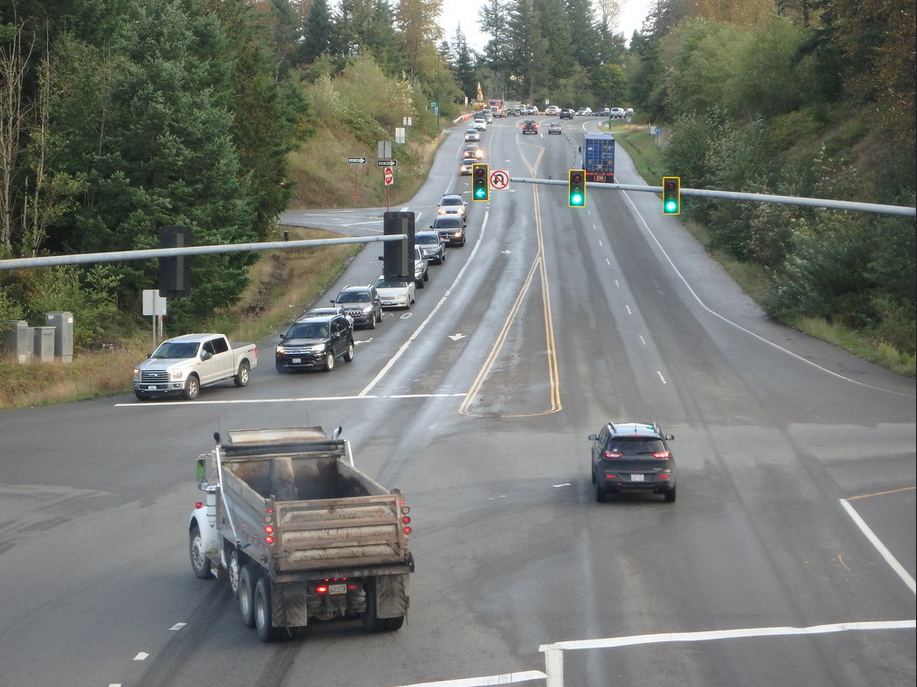 |
.
Historic $5.7 billion construction budget to rebuild our economy
The 2021-23 capital budget proposed by House Democrats would break the record for total investments and put tens of thousands of people to work rebuilding the economy.
Federal funding helps, with the proposed budget (HB 1080) including $400 million in federal funding for investments in water, sewer, and broadband service along with $189 million for critical capital budget projects enabling work, education, health monitoring, and other items related to responding to the pandemic.
A total of $48.5 million would go toward grants and loans for early learning facilities. Public schools would receive $969.9 million, while community colleges get $299.8 million and public universities are set for $678.9 million in construction funding. The largest project is the construction of the Behavioral Health Teaching Facility at the University of Washington ($191.3 million).
 |
This proposal also sets new records for investments in housing ($240 million), early learning ($48 million), and broadband internet access ($155 million).
By comparison, the 2015-17 budget included $75 million for housing, $15.5 million for early learning facilities, and $10 million for broadband.
Read the press release here, or get full details about the budget here. You can also find district project lists and maps.
5th District Highlights
We can’t say at this point exactly how the district will fare in the final capital budget, because the House and Senate versions differ quite a bit. In the next several days those differences will be negotiated and a final budget approved. The House is much more generous, with $54 million in district projects funded, compared to the Senate’s proposed $25 million. We’ll be advocating strongly for a version that incorporates the best of both. Some highlights of House proposal are:
- Nearly $10 million in State Patrol enhancements, including full replacement of the fire academy’s burn building.
- $1 million to expand the Issaquah food bank.
- $360,000 for the Snoqualmie Valley Youth Activity Center in North Bend.
- More than $2 million for fish-passage improvements throughout the district.
- $8 million in wildlife recreation grants to improve park facilities and trails in the 5th district.
- Over $600,000 to renovate and expand the Village Theatre in Issaquah.
- $250,000 to finish funding permanently affordable housing projects in North Bend.
Everybody over 16 years of age will be eligible for COVID vaccines on April 15
In our March 6 newsletter, we reported that 21.2 percent of King County residents had received at least the first shot. In just three and a half weeks, we’ve gone up to 29.84 percent! At this rate, and now with the governor opening up eligibility to everyone age 16 and up on April 15, we’ll be gaining more ground very quickly.
Click here or on the image below to check out the Department of Health Data Dashboard, where you can look up information for every county on demographics, testing, vaccine doses given, hospitalizations, confirmed cases and more.
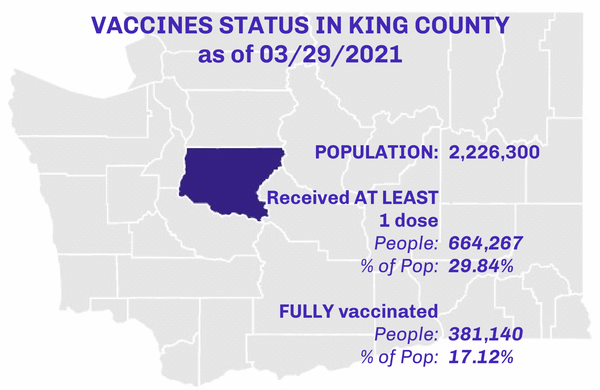 |
The fact that so many people are getting vaccinated is great news, no doubt, but we are not over the hump yet. It is really important that we all continue following the guidelines: keeping our distance, washing our hands thoroughly and frequently and, especially, wearing masks. Our collective success relies on everyone’s commitment to beat this virus. We will only get to the other side if we all head in that direction together.
Small business grant applications opened this week
The Department of Commerce launched a new round of Working Washington small business grants this week. This new round of grants is focused on brick-and-mortar businesses that have been most directly impacted by public health measures. To see if your business may be eligible, please go to commercegrants.com.
Commerce’s technical support center is currently open to answer any questions and they are now able to provide assistance in multiple languages. You can contact them via phone at (855) 602-2722 or email at commercegrants@submittable.com. Trusted community organizations are also providing translation and individualized guidance and their contact information is available through this directory.
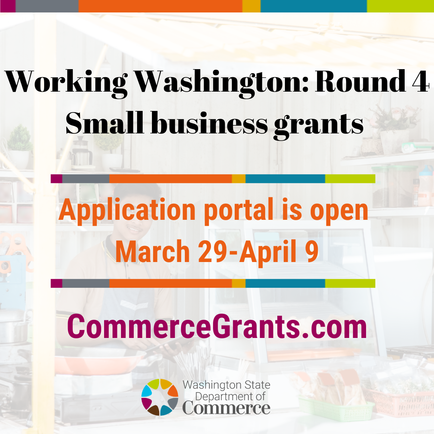 |
This round of Working Washington grants is possible because we approved $240 million in January as part of an early action bill. That bill also included hundreds of millions of dollars to boost public health, keep people in their homes, get students caught up, keep food on the table, and a whole host of other things. It was step one in our plan for community and economic recovery and we are now focused on the next steps in our plan to ensure we recover together.
Keep in Touch
We hope you found this update helpful. And please keep in mind that, while the legislative session itself is coming to a close, we are at your service year-round. It’s not too late to make your feelings known about the things we’ve covered here, and more. So don’t hesitate to contact us and be sure to visit our official Facebook pages for frequent updates: Lisa’s page and Bill’s page.
We work for you, and look forward to hearing your questions, comments, and suggestions about how your government can work better for you, and for all of us.
Sincerely,
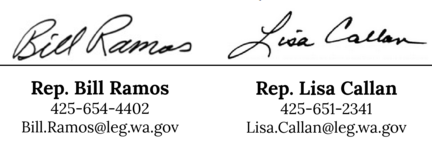 |
